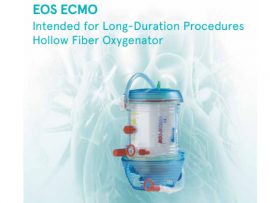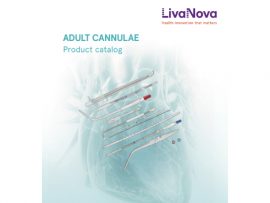Abstract The clinical tolerance of extracorporeal membrane oxygenation (ECMO) membrane changes in acute respiratory distress syndrome (ARDS) patients under veno-venous ECMO (VV-ECMO) has not been reported. The aim of this..
Read MoreAbstract Extracorporeal membrane oxygenation (ECMO) has been primarily used for respiratory and circulatory failure, but its airway-related use has not been investigated well. Tracheal procedures are a situation when ECMO..
Read MoreAbstract Objective To describe the six-month functional outcomes of patients who received extracorporeal cardiopulmonary resuscitation (ECPR) following in-hospital cardiac arrest (IHCA) in Australia. Design Secondary analysis of EXCEL registry data...
Read MoreExtracorporeal membrane oxygenation for Chinese neonates with severe respiratory and cardiac failure
Abstract Objective We aimed to outline the experience with extracorporeal membrane oxygenation (ECMO) for respiratory and cardiac failure in neonates in our institution and compare our results with those from..
Read MoreAbstract Background Children who undergo cardiac surgery may require postcardiotomy extracorporeal membrane oxygenation (ECMO). Although morbidities are considerable, our understanding of outcome determinants is limited. We evaluated associations between patient..
Read MoreAbstract Background Postcardiotomy cardiogenic shock (PCCS) in cardiac surgery is associated with a high rate of morbidity and mortality. Beside other therapeutic measures (e.g. intraaortic balloon pump (IABP)), extracorporeal life..
Read MoreAbstract Veno-venous (VV) extracorporeal membrane oxygenation (ECMO) is associated with fewer neurological complications and decreased mortality compared to veno-arterial (VA) ECMO in neonatal respiratory failure. The Crescent right atrial (RA)..
Read MoreAbstract Mortality remains elevated during venoarterial extracorporeal membrane oxygenation support (VA-ECMO) for cardiogenic shock and the role of inflammation is uncertain. By using the neutrophil-to-lymphocyte ratio (NLR), we investigated inflammatory..
Read MoreAbstract Extracorporeal membrane oxygenation (ECMO) can support patients with severe cardiorespiratory failure presenting with hypoxia who would otherwise have not survived. Patient selection for ECMO is challenging and relies on..
Read MoreAbstract Background Acute lung injury and acute respiratory failure are frequent complications of cardiogenic shock and are associated with increased morbidity and mortality. Even with increased use of temporary mechanical..
Read MoreAbstract Severe accidental hypothermia can lead to cardiac arrest. The most efficient method of resuscitating and warming is by ECMO (Extracorporeal Membrane Oxygenation). While the convention is to use VA..
Read MoreAbstract Over the past two decades, extracorporeal membrane oxygenation (ECMO) has been increasingly used to support critical patients with cardiac and respiratory failure who fail to respond to conventional management...
Read MoreAbstract Cardiac surgery patients are potentially exposed to an acute inflammatory host response with a huge release of both pro- and anti-inflammatory cytokines both through intrinsic (e.g., tissue damage, endothelial..
Read MoreAbstract Background Reliable myocardial protection is essential for a good outcome after arterial switch operation. Patients and Methods We evaluated 56 neonates with arterial switch operation in this retrospective study...
Read MoreAbstract In recent years, there has been an increased utilization of temporary mechanical circulatory support (tMCS) in patients with cardiogenic shock (CS), with many transitioning to recovery or advanced therapies..
Read MoreAbstract While renal replacement therapy (RRT) allows for precise fluid management as well as addressing electrolyte imbalances and the removal of other necessary compounds, its early initiation has not shown..
Read MoreAbstract Background Veno-arterial (V-A) extracorporeal membrane oxygenation (ECMO) is commonly used for patients with cardiac arrest, cardiogenic shock, or heart failure and is a life-saving technique. Computed tomography angiography (CTA)..
Read MoreAbstract Critical illness during pregnancy poses significant challenges driven by complex interactions between physiological changes, pre-existing conditions, and healthcare disparities. In high-income countries, increasing maternal age and comorbidities complicate obstetric..
Read MoreAbstract Background Left ventricular unloading is needed in patients on extracorporeal life support (ECLS) with severely impaired left ventricular contractility to avoid stasis and pulmonary congestion, and to promote LV..
Read MoreAbstract Acute respiratory failure (ARF) strikes an estimated two million people in the United States each year, with care exceeding US$50 billion. The hallmark of ARF is a heterogeneous injury,..
Read MoreAbstract Background: Monitoring the anticoagulant effect of unfractionated heparin (UFH) in extracorporeal membrane oxygenation (ECMO) patients is complex but critically important to balance the risks of treatment related bleeding and..
Read MoreAbstract Multisystem inflammatory disease in childhood (MIS-C) is a novel pediatric syndrome after a COVID-19 infection that causes systemic injury, with potential life-threatening hemodynamic compromise requiring Extracorporeal Membrane Oxygenation (ECMO)..
Read MoreAbstract Rescue Extracorporeal Life Support Programs based at non-cardiac surgery centers have unique needs to be able to ensure successful outcomes despite low patient volumes. In this paper we describe..
Read MoreAbstract Introduction The prolonged use of extracorporeal membrane oxygenation (ECMO) support is associated with increased consumption of platelets and hemolysis. The prognostic impact of thrombocytopenia prior to and during ECMO..
Read MoreAbstract Extracorporeal cardiopulmonary resuscitation (ECPR) is a complex, life-saving procedure that uses mechanical support for patients with refractory cardiac arrest, representing the pinnacle of extracorporeal membrane oxygenation (ECMO) applications. Effective..
Read MoreAbstract Background: Although the Avalon Elite bi-caval dual lumen catheter for veno-venous extracorporeal membranous oxygenation (ECMO) has many advantages, it requires precise positioning and dislodgement is common. Case presentation: A 2-year-old male..
Read MoreAbstract We read with great interest a recent position statement on the physiology and presentation of a means of unambiguous identification of native lung and membrane lung blood flow occurring..
Read MoreAbstract Objective To document the experience with ECMO therapy in healthcare institutions across Latin America between 2016 and 2020. Design Cross-sectional study. Setting Private and public health institutions from 7..
Read MoreAbstract This review focuses on recirculation in the context of Veno-Venous Extracorporeal Life Support in adults. The methods employed to calculate and quantify the extent of recirculation, as well as..
Read More
















